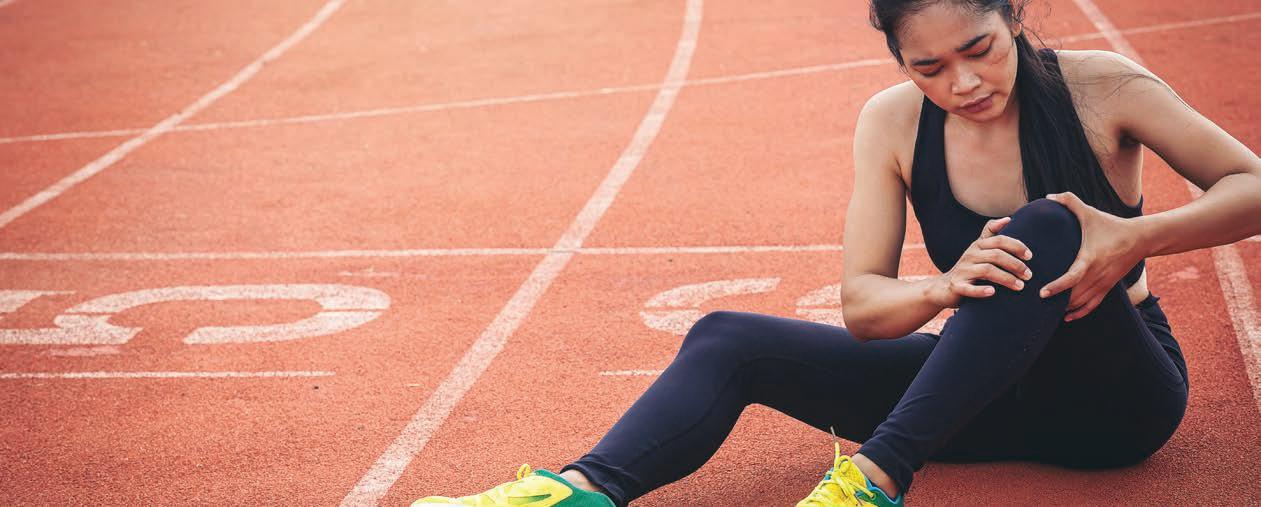
2 minute read
Looking after your ACLs
THE ANTERIOR CRUCIATE LIGAMENT (ACL) IS ONE OF THE MOST IMPORTANT LIGAMENTS IN EACH KNEE. DAMAGING IT CAN BE A DEVASTATING INJURY, OFTEN REQUIRING SURGERY AND A LENGTHY RECOVERY PERIOD. WOMEN ARE MORE LIKELY TO SUFFER THAN MEN – FOR EXAMPLE, FEMALE ATHLETES CAN FACE TWO TO EIGHT TIMES HIGHER RISK.
The ACL is responsible for stabilising the knee joint and preventing it from moving excessively, so you really don’t want to tear it. But why are more women at risk?
Anatomy
Women naturally have wider hips than men, which creates a greater angle between the thigh bone and the shin bone.1 This angle, known as the Q angle, can put more stress on the knee joint and increases the risk of an ACL tear. Additionally, women tend to have smaller ACLs and narrower knee tendons, which can make the ligament more vulnerable to injury.1
Hormones
Research has shown that oestrogen can weaken the ACL and make it more susceptible to injury.2 Of course, women have higher levels of oestrogen than men, and particularly so during their menstrual cycle, which may explain why they are more likely to experience ACL tears during this time.
Biomechanics
Female athletes often move differently from male athletes, which can increase their risk.1 For example, females tend to land from jumps with their knees straighter and their hips rotated inward, which puts more stress on the knee joint.3 They also tend to rely more on their quadriceps muscles, at the front of the thighs, which can cause the shin bone to move forward and puts the ACL at risk of tearing.3
Training and conditioning
Female athletes often receive less training in strength and conditioning than their male counterparts, which can put them at a disadvantage in terms of muscular strength and control.2 This can lead to compensatory movements and an increased risk of ACL injury. Sports such as soccer and basketball have higher rates of ACL tears among females, possibly due to differences in playing style and rule enforcement.
How do we tackle this?
Preventing ACL tears in women requires a comprehensive approach which addresses these multiple factors. Strength and conditioning programs that focus on the muscles surrounding the knee joint can help to improve control and stability and reduce the risk of compensatory movements that can lead to injury.4
Teaching women proper landing techniques, and how to change direction at speed, could also help them to avoid putting unnecessary stress on their knees.4 Additionally, a better understanding of hormonal factors in future could mean timing training and competition schedules, especially individual sports, to avoid high-risk periods during the menstrual cycle – or possibly hormone therapy, in certain cases.
If you tear an ACL
In the event of an ACL tear, prompt and appropriate treatment is crucial. Surgery may be necessary to repair the ligament, followed by a rehabilitation program that includes physical therapy and a gradual return to activity.5 To ensure the best possible outcome, it's important to work with a healthcare provider who has experience in treating ACL injuries.
1The female ACL: Why is it more prone to injury?: https://www.ncbi.nlm.nih.gov/pmc/ articles/PMC4805849/
2Anterior cruciate ligament injury: https://bjsm.bmj.com/content/55/17/984
3Female football players are at much higher risk of career-ending ACL injuries – the science on why: https://theconversation.com/female-football-players-are-at-muchhigher-risk-of-career-ending-acl-injuries-the-science-on-why-198121
4Why female athletes injure their ACLs more frequently: https://www.ncbi.nlm.nih.gov/ pmc/articles/PMC8329328/
5Evidence-based recommendations for the management of anterior cruciate ligament (ACL) rupture: https://www.ncbi.nlm.nih.gov/pmc/articles/PMC6723618/










